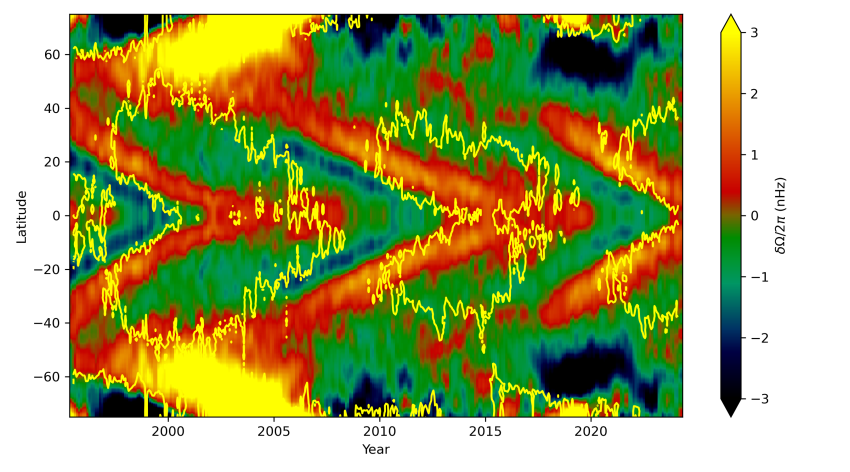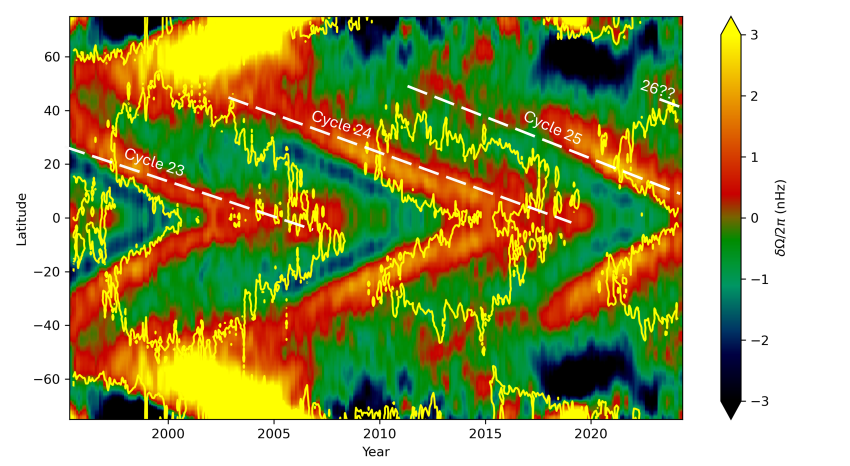"First Traces" Of Solar Cycle 26 Detected On Sun
Scientists from the University of Birmingham in England have detected the "first rumblings"—or first indications—that the sun's next 11-year solar cycle, Cycle 26, will begin by the decade's end.
The current cycle, Cycle 25, has reached what scientists call a "solar maximum," when the sun's magnetic field flips and its poles swap places. This peak is known for elevated solar activity, including sunspots, flares, and coronal mass ejections.
Researchers from Birmingham recently presented the new data at the Royal Astronomical Society's National Astronomy Meeting in Hull. The data shows the first signs that the next solar cycle is beginning.
Astronomers use the sun's internal sound waves to measure how it rotates, making visible a pattern of bands (solar torsional oscillation) that rotate slightly faster or slower. These move towards the sun's equator and its poles during the activity cycle.
The faster-rotation belts tend to show up before the next solar cycle officially begins. -researchers
Research leader Rachel Howe from Birmingham noted a 'faint indication' is beginning to show up after analyzing the pattern of the sun's bands (solar torsional oscillation). The faster-rotation belts tend to show up before the next solar cycle arrives.
"If you go back one solar cycle - 11 years - on the plot, you can see something similar that seems to join up with the shape that we saw in 2017. It went on to be a feature of the present solar cycle, Cycle 25," said Dr. Howe.

She said, "We're likely seeing the first traces of Cycle 26, which won't officially start until about 2030."

Researchers have been analyzing solar torsional oscillation patterns on the sun using helioseismic data from the Global Oscillation Network Group (GONG), the Michelson Doppler Imager (MDI) onboard the Solar and Heliospheric Observatory, and the Helioseismic and Magnetic Imager (HMI) on board the Solar Dynamics Observatory since the mid-1990s. This data now covers Solar Cycles 23, 24, and 25, allowing researchers better to understand the precursors to the next solar cycle.
Howe has been a student of the stars for 25 years, studying the sun's rotation through GONG and MDI data.
"With more data, I hope we can understand more about the part these flows play in the intricate dance of plasma and magnetic fields that form the solar cycle," she concluded.
Several studies (one here) have suggested the sun will experience a new grand solar minimum between 2030 and 2040. This could decrease solar activity, similar to the Maunder minimum in the 17th century. At that time, Earth experienced a period of global cooling known as the Little Ice Age.
But in the meantime, the Tonga eruption in 2022 appears to have fueled global warming, not cow farts or Taylor Swift's private jet.
NEVER MISS THE NEWS THAT MATTERS MOST
ZEROHEDGE DIRECTLY TO YOUR INBOX
Receive a daily recap featuring a curated list of must-read stories.




